#bantu kongo
Explore tagged Tumblr posts
Text

Simbi water spirits are revered in Hoodoo originating from Central African spiritual practices. When Africans were enslaved in the United States, they blended African spiritual beliefs with Christian baptismal practices. Enslaved African Americans prayed to Simbi water spirits during their baptismal services. In 1998, in a historic house in Annapolis, Maryland called the Brice House archaeologists unearthed Hoodoo artifacts inside the house that linked to the Kongo people. These artifacts are the continued practice of the Kongo's minkisi and nkisi culture in the United States brought over by enslaved Africans. For example, archeologists found artifacts used by enslaved African Americans to control spirits by housing spirits inside caches or nkisi bundles. These spirits inside objects were placed in secret locations to protect an area or bring harm to slaveholders. "In their physical manifestations, minkisi (nkisi) are sacred objects that embody spiritual beings and generally take the form of a container such as a gourd, pot, bag, or snail shell. Medicines that provide the minkisi with power, such as chalk, nuts, plants, soil, stones, and charcoal, are placed in the container." Nkisi bundles were found in other plantations in Virginia and Maryland. For example, nkisi bundles were found for the purpose of healing or misfortune. Archeologists found objects believed by the enslaved African American population in Virginia and Maryland to have spiritual power, such as coins, crystals, roots, fingernail clippings, crab claws, beads, iron, bones, and other items assembled together inside a bundle to conjure a specific result for either protection or healing. These items were hidden inside slaves' dwellings. These practices were concealed from slaveholders.

In Darrow, Louisiana at the Ashland-Belle Helene Plantation historians and archeologists unearthed Kongo and Central African practices inside slave cabins. Enslaved Africans in Louisiana conjured the spirits of Kongo ancestors and water spirits by using seashells. Other charms were found in several slave cabins, such as silver coins, beads, polished stones, bones, and were made into necklaces or worn in their pockets for protection. These artifacts provided examples of African rituals at Ashland Plantation. Slaveholders tried to stop African practices among their slaves, but enslaved African Americans disguised their rituals by using American materials and applying an African interpretation to them and hiding the charms in their pockets and making them into necklaces concealing these practices from their slaveholders. In Talbot County, Maryland at the Wye House plantation where Frederick Douglass was enslaved in his youth, Kongo related artifacts were found. Enslaved African Americans created items to ward off evil spirits by creating a Hoodoo bundle near the entrances to chimneys which was believed to be where spirits enter. The Hoodoo bundle contained pieces of iron and a horse shoe. Enslaved African Americans put eyelets on shoes and boots to trap spirits. Archaeologists also found small carved wooden faces. The wooden carvings had two faces carved into them on both sides which were interpreted to mean an African American conjurer who was a two-headed doctor. Two-headed doctors in Hoodoo means a conjurer who can see into the future and has knowledge about spirits and things unknown.
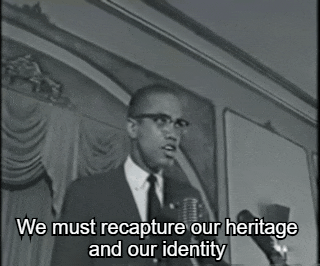
At Levi Jordan Plantation in Brazoria, Texas near the Gulf Coast, researchers suggests the plantation owner Levi Jordan may have transported captive Africans from Cuba back to his plantation in Texas. These captive Africans practiced a Bantu-Kongo religion in Cuba, and researchers excavated Kongo related artifacts at the site. For example, archeologists found in one of the cabins called the "curer's cabin" remains of an nkisi nkondi with iron wedges driven into the figure to activate its spirit. Researchers found a Kongo bilongo which enslaved African Americans created using materials from white porcelain creating a doll figure. In the western section of the cabin they found iron kettles and iron chain fragments. Researchers suggests the western section of the cabin was an altar to the Kongo spirit Zarabanda
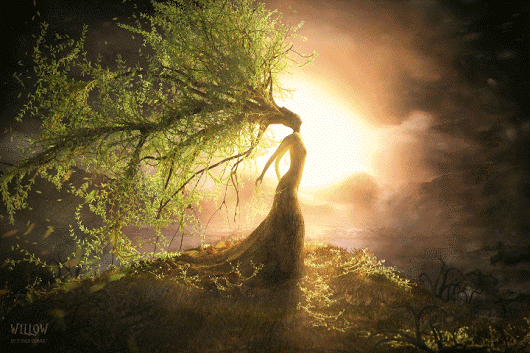
#zarabanda#bilongo#nkisi nkondi#bantu kongo#cuba#texas#levi jordan#african#afrakan#kemetic dreams#africans#african culture#afrakan spirituality#afrakans#frederick douglass#Ashland-Belle Helene Plantation#Darrow#Louisiana#simbi#water#water spirit#baptism#christianity#christian broadcasting network#christian living#christian doctrine#christian faith#hoodoo#vodun#voodoo
285 notes
·
View notes
Text
Exploring the Rich Linguistic Heritage of Kikongo and Kituba Languages in the Kongo Kingdom
Uncovering the Secrets of the Kikongo Language and People Located in the heart of Central Africa, the Kikongo language has a rich cultural heritage that has been passed down through the centuries. This ancient language spoken by the Bakongo people provides fascinating insight into the region’s history, traditions and way of life. In this article, we delve into the fascinating world of the…

View On WordPress
#African Languages#Bakongo people#Bantu languages#Cultural Heritage#inclusivity#Interpretation Services#Kikongo language#Kongo Kingdom#Language Preservation#LanguageXS
2 notes
·
View notes
Text

Nós.
Nankin sobre tela.
15cm x 15cm.
#cosmograma bakongo#spiritual knot#bantu#dikenga#bantu-kongo#kongo#fu-kiau#azul#blue#black#preto#nankin
5 notes
·
View notes
Video
youtube
Lyrics Cicatrice d'amour - Tshala Muana
#youtube#RIP#Mutwashi Queen#Tshala Muana#tshiluba#Muluba#kiluba#Baluba#Drc#artist#artists#artists on tumblr#Mutwashi#Mutuashi#culture#kongo#bantu
2 notes
·
View notes
Text
Les Kongos de Guadeloupe
“L’abolition définitive de l’esclavage en 1848 pousse les colons à se tourner vers une nouvelle main-d’œuvre. D’abord européenne puis cap-verdienne et indienne, cette main-d’œuvre va à nouveau concerner l’Afrique et même se concentrer sur le Congo entre 1858 et 1861. Des Kongos qui vont pour la plupart se faire discrets dans un pays où la société créole déjà bien constituée, va les rejeter. Ils…

View On WordPress
0 notes
Photo

Kingdom of Kongo
The Kingdom of Kongo (14-19th century CE) was located on the western coast of central Africa in modern-day DR of Congo and Angola. Prospering on the regional trade of copper, ivory, and slaves along the Congo River, the kingdom's wealth was boosted by the arrival of Portuguese traders in the late 15th century CE who expanded even further the slave trade in the region. Kongo kings were converted to Christianity but relations with the Europeans deteriorated as each side attempted to dominate the other. Civil wars and defeats to rival neighbouring kingdoms finally saw the Kongo state collapse in the early 18th century CE. The Portuguese reinstalled the position of the Kongo monarchs, and the state limped on in name only well into the 19th century CE but the kingdom's days as the strongest power in west-central Africa were now but a distant memory.
Formation & Territory
Located on the western coast of central Africa and south of the Congo River (formerly known as the Zaire River), the kingdom arose in the late 14th century CE following the alliance of several local principalities which had been in existence since the second half of the first millennium CE. Kongo, dominated by Bantu-speaking peoples, had its capital at Mbanza Kongo - known to the Kongolese as Banza, meaning 'residence of the king' - which was located on a fertile and well-watered plateau just below the western end of the Congo River. The kingdom expanded its territory further by a gradual process of military conquest, probably motivated above all by a desire to acquire slaves. At its peak in the 15th and 16th century CE, the kingdom controlled some 240 km (150 miles) of the coast from the Congo River in the north to just short of the Cuanza River in the south, and spread some 400 km (250 miles) into the interior of central Africa up to the Kwango River.
Continue reading...
40 notes
·
View notes
Text
Click the Title Link to DOWNLOAD for Free from the BLACK TRUEBRARY

Click the Title Link to DOWNLOAD for Free from the BLACK TRUEBRARY
Outside of Cuba, Palo is generally called Palo Mayombe ; however, this is a misnomer since not all lineages and houses are truly Mayombe – in fact, most are not. To my knowledge there is only one (perhaps a couple) Munanzo outside of Cuba that are accepted as a true Mayombe houses amongst the elders on the Island.

In Cuba, “Palo Monte” is used far more frequently to speak to the entire body of Regla-Kongo Palo tradition. Other terms such as Palo Cruzado (‘crossed palo’, denoting heavy syncretization with other religions), Palo Cristiano (‘Christian palo’) and Palo Judio (‘Jewish palo’, not actually jewish, but simply non-Christian) deserve a brief mention. However, these are not specific ramas of Palo, but rather terms that are used to denote the degree of syncretism and mixing in individual lineages and practices.
There are many houses (munansos) and foundational lineages (ramas) of Palo Monte, but commonly they are understood to fit within three major forms or sub ‘reglas’ within the greater Regla-Kongo:
Mayombe
Biyumba (Vrillumba o Brillumba)
Kimbiza
Palo Mayombe is the oldest and most orthodox form of Palo. The origins trace back to a specific Nkisi cult in the Mayombe region of Cabinda (NW Congo) from where it gets its name and the tradition came into its own in the caves and wilderness of the Pinar del Rio highlands of Cuba. Mayomberos typically shun away from syncretism and are extremely orthodox in our practices. The most well known of the Mayombe houses are the houses of “Batalla Saca Empeño” and “Bejuco Nfinda”.
Palo Biyumba developed out of Palo Mayombe and rose in popularity during Cuba’s war of Independence. It was the first regla to initiate people of non-Bantu ancestry and frequently worked with and developed pacts with dead spirits of no particular blood or spiritual lineage (often times to send them out for warring intentions). It is a vast regla and has many ramas and sub-lineages. Indeed, a great number of houses today are some offshoot of Biyumba. Broadly speaking, Palo Biyumba is more oriented toward the various mpungos and over time some lineages have introduced a degree of syncretization with elements of Ocha and Catholicism.
Palo Kimbisa was popular on the eastern side of the Cuban island and has absorbed many influences from Catholicism to Freemasonry to Haitian Vodou. Kimbisa likely originated within an already syncretized Catholic-Kongo religious tradition from the Kingdom of Kongo following Kimpa Vita’s Christian reform in the 18th C. In Kimbisa the mpungos are paramount and are seen as divinities and saints. Thus, Kimbiseros will venerate the mpungos and focus much of their work calling upon them, instead of upon the dead. The most well known Kimbisa rama is Andrés Petit’s La Regla Kimbisa de Santo Cristo del Buen Viaje.
The Kimbisa prendas/ngangas I have seen also tend to be huge in comparison to Mayombe. Although my elders have reassured me that there are Kimbisa prendas that are built almost identical to Mayombe as there is more variance per house/lineage than across the greater sub-reglas. It is also common to see Kimbisa (as well as Briyumba) prendas with crucifixes. Moreover, many Kimbiseros and Biymberos will make a distinction between prendas judias or prendas ndoki(those without crucifixes and containing the bones of non-baptized individuals) used to curse, kill, and other malefica; and prendas cristianas (with cross and baptized nfumbe) used to heal and general benefica. This distinction does not appear in Mayombe.
Assortment of now defunct/dormant Briyumba Ngangas on display in the Museo Municipal de Regla
Click the Title Link to DOWNLOAD for Free from the BLACK TRUEBRARY
14 notes
·
View notes
Text
Black Man At The Crossroads Day
Happy Halloweeeeen Hoodoos!! On this final day of Hoodoo Heritage Month, we celebrate the Black Man at the Crossroads Day. 💀🖤

The Crossroads is integral to the religious fabric of Kongo Cosmology. At the crux of ancient ancestral wisdom (the Kalunga line) and the realm of the living (the Mukala line), is our place of significant power, transformation, & Spirit.
Here, we meet The Black Man (not to be confused with The Devil); a Kongo-Bantu ancestral spirit who is a gatekeeper of closed/open roads & conductor of the spiritual energies at the Crossroads, which catalyze shifts, changes, + movement from the spirit world into the physical world.
When we go to The Crossroads to sing, dance, pray, invoke, petition our spirits or to conjure, forage, consecrate workings, deliver/dispose offerings… we come to The Black Man, among many other spirits.
Today we celebrate him, acknowledge his presence, and give specific offerings as tokens of gratitude and thanks.
As with any ancestral or Hoodoo Spirit, cultivating a healthy relationship & honoring the principles of energy exchange is paramount. Come correct or not at all. And respect his gangsta.
#hoodoo#hoodoos#atr#atrs#the hoodoo calendar#Black man at the Crossroads#hoodoo heritage month#Hoodoo Heritage#Hoodoo Spirits#Black man#Hoodoo Religion#Hoodoo Cosmology#Hoodoo Tradition#Hoodoo Holidays
47 notes
·
View notes
Text
More on Hoodoo (spirituality)
In my previous post I talked about traditional hoodoo where it started I want to talk a little more on it.
Let's start with this 'The origins of the word Hoodoo which actually comes from the real term "Hudu", meaning "spirit work," coming from the Ewe language spoken in the West African countries. No. It does not come from Africa but African Americans in the American south.
As I mentioned in a past post the term Hoodoo mean that you are sending someone up the river, the upper room. aka death. This is what it means. But in this time it's use to represent all forms of root work in this practice or others. This was started by marketeers.
SWEETENING JARS:
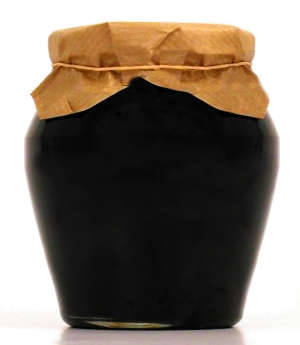
Traditional Sweeting Jar
Sweetening jars is traditional in Hoodoo to sweeten a person or a situation in a person's favor. The practice is appropriated and its meaning is misunderstood outside the African-American community. Traditionally sugar is added to water and used.. Not Honey.
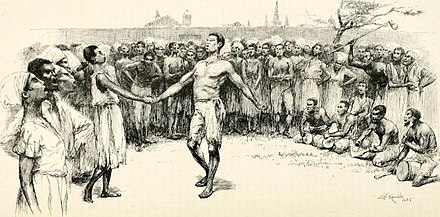
During the slave trade, the majority of Central Africans imported to New Orleans, Louisiana were Bakongo (Bantu people). This image I like and wanted to show it if anyone hasn't seen it. It was painted in 1886 and shows African Americans in New Orleans performing dances from Africa in Congo Square. Congo Square was where African Americans practiced Voodoo and Hoodoo. ("So again when any non traditional Root Worker says there isn't a little voodoo with hoodoo there wrong")
Next we have this diagram the Kongo Cosmogram Cross.
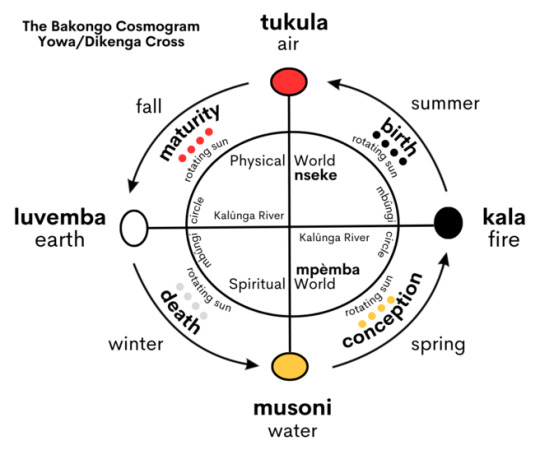
Kongo Cosmogram aka Crossroads.
The Kongo cosmogram aka The Crossroads is from Bakongo origins. This shows how different African religions teach simulator things.
Why is it important? The basic form of this symbol is a simple cross (+) which (symbolizes the rising of the sun in the east, the setting of the sun in the west, and represents cosmic energies.)
This shows that we do use the sun but not the moon like books may teach.
However, the cross is not the same as your typical Christian cross.
The vertical line of the cosmogram is the path of spiritual power from God at the top traveling to the realm of the dead below where the ancestors reside.
The horizontal line in the cross represents the boundary between the physical world which is the (realm of the living) and the spiritual world (realm of the ancestors).
The horizonal line is a watery divide that separates the two worlds from the physical and spiritual, and thus the "element" of water plays a role in African American spirituality just like Voodoo.
The Kongo cosmogram cross symbol has a physical form in Hoodoo called the crossroads where Hoodoo rituals are performed to communicate with spirits.
Dancing: Counterclockwise sacred circle, dances in Hoodoo are performed to communicate with ancestral spirits using the sign of the Yowa cross.
The Ring shout Is Not Part of traditional Hoodoo as far as the actual rituals are concerned, but it is part of church that has its own origins. The ring shout follows the cyclical nature of life that we see in the diagram. It represents Kongo cosmogram of birth, life, death, and rebirth.
Through counterclockwise circle dancing, ring shouters built up spiritual energy that resulted in the communication with ancestral spirits, and led to spirit possession by the Holy Spirit or ancestral spirits. The spiritual vortex in the center of the ring shout is a sacred spiritual realm. The center of the ring shout is where the ancestors and the Holy Spirit reside at. The ring shout tradition continues in Georgia. Inside reflective materials and the used of reflective materials to transport the recently deceased to the spiritual realm. Broken glass on tombs reflects the other world. It is believed reflective materials are portals to the spirit world.
#Hoodoo Lesson#spiritual#like and/or reblog!#traditional hoodoo#rootwork#google search#southern hoodoo#Hoodoo history#Real hoodoo#ask me anything#Hoodoo initiation#Ring shot#follow my blog#ask me questions#message me
76 notes
·
View notes
Text
Hello Beloved...Who Am I?

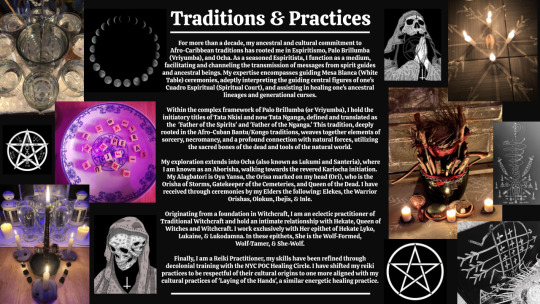
Hi, I am Luar Wolf, and I use Lulu. 32 years old. Sun in Aries, Rising Leo, Moon in Capricorn. I home many identities in my lived experiences carrying each with honor and grace. I am Puertorriqueñx and Dominicanx with ancestral roots and lineages of Afro-Descendiente, Indigenous Taino, and Basque-Iberian. I am non-binary, trans, queer, and intersex. I was born, raised, and lived on Occupied Munsee Lenape Land (New York City). I currently live in Philadelphia, Pennsylvania.
For more than a decade, my ancestral and cultural roots in Afro-Caribbean traditions have evolved into practicing Espiritismo, Palo Brillumba (Vriyumba), and Ocha. As a seasoned Espiritista, I function as a medium, facilitating and channeling the transmission of messages from spirit guides and ancestral beings. My expertise encompasses guiding Mesa Blanca (White Table) ceremonies, adeptly interpreting the guiding central figures of one's Cuadro Espiritual (Spiritual Court), and assisting in healing one's ancestral lineages and generational curses.
Within the complex framework of Palo Brillumba (or Vriyumba), I hold the initiatory titles of Tata Nkisi and now Tata Nganga, defined and translated as the 'Father of the Spirits' and 'Father of the Nganga'. This tradition, deeply rooted in the Afro-Cuban Bantu/Kongo traditions, weaves together elements of sorcery, necromancy, and a profound connection with natural forces, utilizing the sacred bones of the dead and tools of the natural world.
My exploration extends into Ocha (also known as Lukumi and Santeria), where I am known as an Aborisha, walking towards the revered Kariocha initiation. My Alagbatori is Oya Yansa, the Orisa marked on my head (Ori), who is the Orisha of Storms, Gatekeeper of the Cemeteries, and Queen of the Dead. I have received through ceremonies by my Elders the following: Elekes, the Warrior Orishas, Olokun, Ibejis, & Inle.
Originating from a foundation in Witchcraft, I am an eclectic practitioner of Traditional Witchcraft and hold an intimate relationship with Hekate, Queen of Witches. I work exclusively with Her epithet of Hekate Lyko, Lukaine, & Lukodamna. In these epithets, She is the Wolf-Formed, Wolf-Tamer, & She-Wolf.
Finally, I am a Reiki Practitioner. My skills have been refined through decolonial training with the NYC POC Healing Circle. I have shifted my reiki practices to be respectful of their cultural origins to one more aligned with my cultural practices of 'Laying of the Hands', a similar energetic healing practice.
In my community work, I am dedicated to crafting sacred spaces grounded in a decolonial and healing justice framework. My focus is on nurturing the transformative journey, embracing the metamorphosis into the rooted sacredness of our true selves. Drawing upon the intricate webs of ancestral lineages, I actively dismantle generational trauma and break curses through the practice of ancestral veneration and spirit work.
I extend an invitation to you to engage with my approach by bringing your full authenticity, sharing your personal truths, and embracing your lived experiences. Together, let us embark on the profound work of honoring ourselves, ancestors-in-the-making. As the living dreams and legacy of those who paved the way before us, we straddle two worlds—one foot planted firmly in this reality and the other in the realm where we connect with ancestral dead and our guiding spirits, present in our first and last breaths.
Sincerely,
La Loba Luna Luz,

#queer#nonbinary#trans#intersex#femmequeen#latinx#nonbinarylatinx#nonbinaryofcolor#transnonbinary#nonbinaryisntwhite#witchcraft#witch#bitchcraft#slutcraft#bruja#brujx#brujeria#witchesturncounselors#goddexx#progressivewitchcraft#lukumi#lucumi#afrocaribbean#santeria#regladeocha#aborisa#tatankisi#tatanganga#palero#palobrillumba
2 notes
·
View notes
Text
🚨NEW VIDEO OUT NOW🚨
https://youtu.be/kB9DYRP7g-w
IUIC 🇨🇩🇨🇬CONGO🇨🇩🇨🇬 KIMBANGISTE OU ISRAÉLITE
.…………………………………….
Visit our website here 💻👨🏾💻🖥
🔴 https://solo.to/unitedinchrist
#pourtoi #congo #fyp #congokinshasa #congobrazzaville #congolese #congolaise #image #christ #belgique #france #french #lingala #lingalafacile #banacongo #banakin #banakinshasa #banabrazza #kongo #bantu #noir #afrique #africa
2 notes
·
View notes
Text
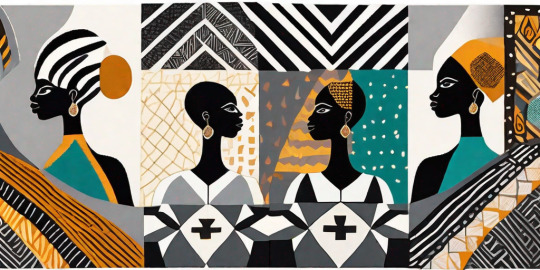
Bakongo spiritual protections influenced African American yard decorations. In Central Africa, Bantu-Kongo people decorated their yards and entrances to doorways with baskets and broken shiny items to protect from evil spirits and thieves.
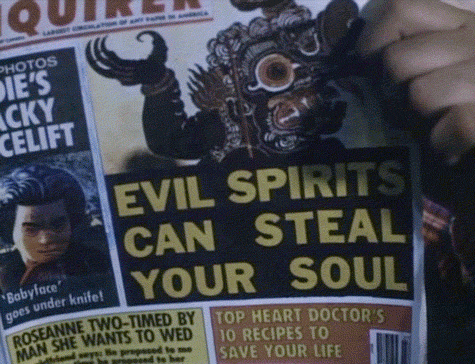
This practice is the origin of the bottle tree in Hoodoo. Throughout the American South in African American neighborhoods, there are some houses that have bottle trees and baskets placed at entrances to doorways for spiritual protection against conjure and evil spirits.
In addition, nkisi culture influenced jar container magic. An African American man in North Carolina buried a jar under the steps with water and string in it for protection. If someone conjured him the string would turn into a snake. The man interviewed called it inkabera

#inkabera#nkisi#hoodoo#african american#african traditional religions#kongo#bantu#central africa#north carolina#bottles#african#afrakan#kemetic dreams#africans#brownskin#afrakans#african culture#afrakan spirituality#glass#dishware#wood#glassware#hearts
228 notes
·
View notes
Text
African Cosmology of the Bantu-Kongo (Bunseki Fu-Kiau) Chapter 4 #WeAreR...
Last in the series on this fascinating African philosophy book. I definitely want to read more of Bunseki Fu-Kiau's work.
2 notes
·
View notes
Text

Dois mundos.
Nankin, acrílica e guache sobre tela.
15cm x 20cm.
#bakongo#bantu-kongo#bakongo cosmology#dikenga dya kongo#cosmograma bakongo#cultura negra#painting#nankin#fu-kiau
1 note
·
View note
Video
youtube
LA RUMBA CONGOLAISE, HISTOIRE ET ÉCONOMIE I FILM-DOCUMENTAIRE (Didier MUMENGI)
#youtube#RUMBA#KUMBA#MAKUMBA#BANTU#LA RUMBA CONGOLAISE#CONGO#KONGO#DRC#ANGOLA#CUBA#Music#dance#origin
1 note
·
View note
Text

In order to deepen your connection to Hoodoo-Conjure you have to connect with the Earth.
KONGO BLOOD
The Bantu-Kongo being one of the main influences of Hoodoo-Conjure there is a necessity to learn the lands in which you reside in order to bring about change and different occurrences in your life.
It’s the Earth that empowers us, heals us, nurtures us…. And everything we need she provides. In the mundane & spiritual! We bring different sources together to work as one (Nkisi/Mojo). Bringing together the forces of nature, the dead, and the natural powers of our world to defend, draw money, guide, and anything else we may seek in this lifetime.
The Dead are our main points of interest in Hoodoo-Conjure because of the vast amount of knowledge & strength they have. Especially as African Americans! Visiting the rivers, cemeteries, and crossroads where not only natural powers ( Crossroads Man, Cymbee….) reside but where our forefathers have been buried, left, and unattended can still be forged! Elevated! And made to be a force to be reckoned with.
This is Conjure! This is what (yt ppl) would rather us not know! That our power is strong and fierce.
4 notes
·
View notes